Peer Reviewed
Feature Article Endocrinology and metabolism
Papillary thyroid cancer: the most common endocrine malignancy
Abstract
Papillary thyroid cancer has an excellent prognosis and over 90% of affected patients achieve long-term survival. Treatment is primarily by surgery and postoperative radioactive iodine ablation, which may be required to be repeated in cases of recurrence.
Key Points
- The main risk factors for papillary thyroid cancer are childhood radiation exposure and a family history.
- A thorough history and examination, followed by appropriate investigations, are required when a patient presents with a neck lump suspected to be thyroid cancer.
- The initial treatment of papillary thyroid cancer consists of surgery with or without postoperative radioactive iodine ablation.
- During follow up, disease-free status is defined by: no clinical evidence of tumour; no evidence of tumour on imaging; and an undetectable serum thyroglobulin level.
- As different specialists are involved at different stages of the management of thyroid cancer, the involvement of the GP from the initial diagnosis to the long-term follow up of the patient may provide a point of contact for the patient, a source of forgotten information, and a sense of continuity of care.
Purchase the PDF version of this article
Already a subscriber? Login here.

